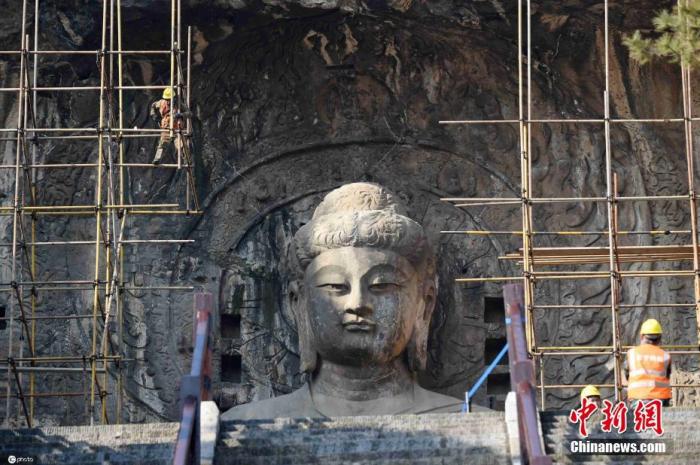China News Service, Luoyang, Henan, December 7 (Reporter Han Zhangyun) The reporter learned from the Longmen Grottoes Research Institute on the 7th that the large-scale water leakage treatment and dangerous rock mass reinforcement protection project of the Longmen Grottoes at Fengxian Temple has been launched, with an estimated construction period of 270 days.
It is reported that this is the first major protection project in Fengxian Temple of Longmen Grottoes in 50 years since the 1970s.
On December 6, Luoyang City, Henan Province, the Longmen Grottoes Fengxian Temple large-scale leakage treatment and dangerous rock mass reinforcement protection project started.
It is reported that this is the first large-scale protection project since the Fengxian Temple's protection and restoration project was carried out in the 1970s.
Image source: ICphoto
The Longmen Grottoes, located in Luoyang City, Henan Province, were first carved in the reign of Emperor Xiaowen of the Northern Wei Dynasty, flourished in the Tang Dynasty, and finally in the late Qing Dynasty. They have been constructed for more than 1,400 years. They are the world's longest construction time, the most statues, and the largest stone carving art treasure house in 2000. It was included in the World Heritage List and became a world cultural heritage.
Among them, Fengxian Temple where the Great Buddha of Luxena is located is the essence of Longmen Grottoes.
According to Shi Jiazhen, Dean of the Longmen Grottoes Research Institute, the restoration of the Longmen Grottoes is mainly concentrated in Fengxian Temple, Leigutai, and caves such as Wanfo Cave and Guyang Cave, which are significantly affected by this year’s rainfall. , Reinforce the dangerous rock mass.
At present, scaffolding has been erected in front of Fengxian Temple, and the staff are intensively constructing.
The restoration area of Fengxian Temple in Longmen Grottoes is the main body of Fengxian Temple's cultural relics and surrounding rock masses. The project was carried out in accordance with the content of the plan approved by the State Administration of Cultural Heritage of China and the Henan Provincial Administration of Cultural Heritage. , The width is about 70 meters.
At the same time, in accordance with the approved plan, emergency support and routine maintenance were carried out for the rock masses of Leigu Tainan Cave and Ming Dynasty brick arches with safety and stability problems, and for the Wanfo Cave, Guyang Cave and other caves, cracks were sealed and seepage prevention , Waterproof and drainage of cave niches, construction of small cave eaves, reinforcement of dangerous stones, etc.
It is reported that water seepage and dangerous rock diseases are the main factors that threaten the safety of cultural relics in Longmen Grottoes.
"Leaking water can cause the dissolution of the carbonate rock mass in the Longmen Grottoes, destroying the integrity of the rock mass and the carvings, and the dissolution will re-form calcium carbonate accumulation on the surface of the cave carvings, reducing the artistic value of the carvings. Water leakage can also cause The change of humidity in the cave accelerates the rate of chemical weathering on the surface of the rock mass. Moisture can promote the growth of microorganisms such as moss and form rough gray-green or gray-black attachments on the surface of the grotto. Dangerous rock masses can cause rock masses and carvings to collapse and fall off. The destruction of cultural relics also seriously threatens the personal safety of tourists." Shi Jiazhen said that starting this restoration project is very important to the protection of the cultural relics of the Longmen Grottoes.
According to the officially approved restoration plan, the Longmen Grottoes Fengxian Temple Protection Project was constructed in a semi-open manner in order to reduce the impact on visitors. Complete the main project before Luoyang Peony Cultural Festival.
Shi Jiazhen said that during the restoration project, the scenic area of Longmen Grottoes was normally open to the public, and visitors could enjoy the face of the iconic statue of the Longmen Grottoes as usual.
(over)

